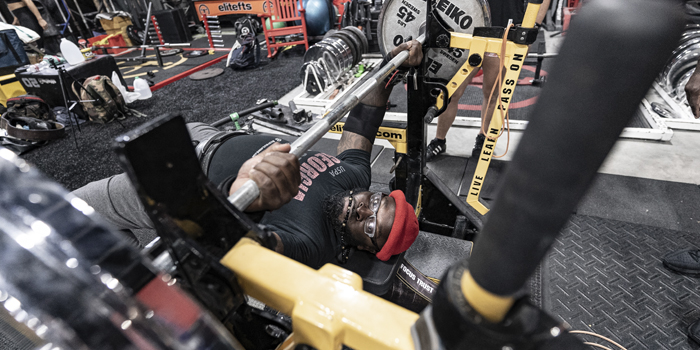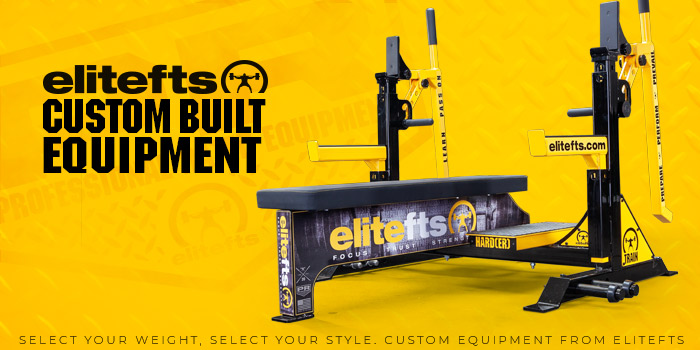
The bench press is arguably the most well-known exercise in the world. It's the king of the upper body lifts, and the only lift egregiously lied about by everybody's uncles' friend who benched 500 pounds in high school.
In continuation of the series, here are movement tiers for bench press weakness.
The bench will have five-movement tiers (the main movement tier and tiers 1-4). Realize tiers 3 and 4 never change. Tier 3 is always "ultra" high reps (30-100 reps) to add blood flow and recovery. Tier 4 is always abdominal work. I'm partial to high rep standing abs or stabilizing exercises like planks, dead bugs, and Pallof presses for time. These are the non-negotiables every athlete can benefit from.
PART 1: Movement Tiers for Squat and Deadlift Weakness
If you're not rooting your feet (yes, even in bench pressing) and bracing your core to help maintain complete tightness and correct arch position, you're leaving pounds on the platform. Rooting and bracing are two very trainable techniques to help correct weakness.
As always, let's pay homage to those giant shoulders you and I both stand on. These movement tiers have been organized and created with my own experience and Christian Anto, Brandon Smitley, Louie Simmons, and more.
Movement Tier Breakdown
Main Movement Tier
- Priority compound movement of the day, variation to bench press
Tier 1 Movement
- Triphasic backdown (refer to Christan Anto's page for more on this) or backdown sets of the main movement of your next prioritized compound movement
Tier 2 Movement
- Normally a single joint or unilateral non-compound movement
Tier 3 Movement
- Ultra high-rep movements, 30-100 reps
Tier 4 Movement
- The often overlooked and underutilized abdominal training
Now that we have a definition of each of the tiers, we can better understand how to organize our training, whether it's max effort, dynamic effort, or a sub-maximal day.
Let's take a look at the following sections and utilize the tier approach:
- Section 1: Missing At/Off the Chest
- Section 2: Elbow Flaring
- Section 3: Midway/Lock-out Miss
Section 1: Missing At/Off the Chest
Whenever I talk about missing at the chest, I AM NOT REFERRING TO you taking 50 pounds more than you're capable of and getting the bar stapled to your chest and screaming like a seagull in a Mcdonald's drive-thru. A true miss off the chest is when you put a 1-board on your chest and take a weight that would crush you on the chest. Another true miss is when it looks like you struggle to death to get it two inches off your chest, then you blow it up faster than me running to an all-you-can-eat buffet.
Main Movement Tier:
- Long Pauses
- ½-Board and 1-Board
- Foam Presses
- Bench Press vs. chains or bands
- Floor Press
- Incline Press
- Spoto Press
- Cambered Bar Bench
- Illegal Wide Grip Bench
- All with or without bands, chains, or weight releasers, using any specialty bar and with any hand placement (preferred mid- wide grip)
Tier 1 Movement:
- Triphasic backdown sets
- Backoff sets
- Overhead Press
- Dumbbell Press (incline, decline, flat, and seated)
Tier 2 Movement:
- Single-Arm Press
- Face Pulls
- Front Shoulder Raises (dumbbell, kettlebell, plate, or cable)
Sample Training Session
Warm-up
- Diaphragmatic Breathing and RPR drills
- Scap Pull-ups and Tri Pushdowns 2x10 and 2x20
Main Movement
- Spoto Press 1RM (slightly above sticking point)
Tier 1 Movement
- Spoto Press 3x3-5x65-70% pauses
Tier 2 Movement
- Single-Arm Incline Press 5x8 superset Chest Supported DB Row 5X8-12
Tier 3 Movement
- Band Pull Aparts 3x30-50
Tier 4 Movement:
- Standing ABS 3x30
Don't be a superhero here. Get in good solid off the chest work and make sure not to neglect your upper back and lats in every training session somehow if you want to be exceptionally strong and help to keep the pecs out of danger.
Section 2: Elbow Flare
In my opinion, elbow flare is THE most common issue in raw bench pressing. There's a lot of positional and technique issues that can come into play here, but it's more than likely your elbows (triceps) are weaker than a fresh pile of baby shit. Most powerlifters heavily rely on the triceps to bench. I'm not saying that pecs and shoulders aren't important, they most definitely are, but triceps help with power out of the bottom and injury mitigation. If your triceps can't lock the weight out, you can't bench press it, plain and simple.
If the elbows are too weak to finish the press, the body completes the task using the deltoids. The problem here is early flaring of the elbowd can lead to pec and delt injuries. So, for the sake of argument, let's try out what I am proposing and see if we can add some pounds to our sub-par presses.
Main Movement Tier
- 1-Board Press
- Foam Press
- Reverse Band Presses at varying heights
- Close grip variations
- Close Grip Floor Press
- All with or without bands chains or weight releasers using any specialty bar
Tier 1 Movement
- Triphasic backdown sets
- Backoff sets
- JM Press
- 2-5-Board
- Close Grip Bench
Tier 2 Movement
- DB Rolling Extensions, Skull Crushers, Tate Press, DB Rows
Sample Training Session
Warm-up
- Diaphragmatic Breathing and RPR drills
- Scap Pull-ups and Triceps Pushdowns 2x10 and 2x20
Main Movement
- Foam Press 1RM
Tier 1 Movement
- Foam Press 3x5x70%
Tier 2 Movement
- Tate Press 5x8 superset w/ 2-Arm DB Row 5x12-15
Tier 3 Movement
- Band Pushdowns 3x30-50
Tier 4 Movement
- Feet Elevated Plank 3x30-45 secs
Watching elbow flare hurts, never mind when it happens to you. Strengthen your weak link to become a complete bencher. Seriously though, why wouldn't anyone want to have bigger, stronger triceps, or "back arms" as Josh Bryant calls them.
Section 3: Midway/Lockout Miss
Some would argue that elbow flare and a midway/lockout miss would be the same. Just because you miss at lockout doesn't mean it was due to elbow flare.
Main Movement Tier
- 2-, 3-, 4-Board press
- Floor Press
- Pin Press
- Cambered Squat Bar Press
- All with or without bands, chains, or weight releasers using any specialty bar
Tier 1 Movement
- Triphasic backdown sets
- Backoff sets
- JM Press
- 2-5-Board
- Close Grip Bench
Tier 2 Movement
- DB rolling Extension, Skull Crushers, Tate Press, DB Rows
Sample Training Session
Warm-up
- Diaphragmatic Breathing and RPR drills
- Scap Pull-ups and Tricep Pushdowns 2x10 and 2x20
Main Movement
- 2-Board Press with two chains per side 1RM
Tier 1 Movement
- JM Press 3x5x70%
Tier 2 Movement
- Single-Arm Incline Tate Extension 5x12 superset w/ 1-Arm DB Row 5x12-15
Tier 3 Movement
- Band Pushdown Ladder (mini band, monster mini, and light 3x20 each band no rest)
Tier 4 Movement
- GHR Sit-ups 3x15 secs
The accessories have overlap, as do the last two sections. I can't help but reiterate DO NOT REINVENT THE WHEEL. Apply common sense and look at yourself objectively and honestly. See a weakness, hit it until it's a strength, then find a different weakness and continue this vicious cycle until you're worm food.
I was one of those lifters (still am) where I hated the bench press because I was stuck for a long period of time, when I knew I shouldn't have been. Guess what? Applying common sense and REAL LIFE HARDWORK has paid off in the past, and I'm willing to bet it'll do so in the future.
Become obsessed with what you love! For me, I'm obsessed with strength training and everything that encompasses it. Become a student to the game, read everything you can, listen to any coach or lifter, attend seminars, and ask questions.
Find and seek out those who are smarter and more experienced. GIVE A FLYING F*CK. You'll be surprised what you and I can accomplish.

Chad Faria is a competitive powerlifter (raw with wraps) from New Bedford, Massachusetts. He owns Bristol County Barbell club—a one-car garage and a 450-square-foot carport. Chad is a Westside Special Strengths Coach, RPR Level 1 Practitioner, PN1 Coach, and ISSA Master Certified Personal Trainer. Aside from his son, fiancé, and livelihood, his barbell club is one of the biggest priorities in his life. Chad's goal is to help whoever is serious about becoming the most dangerous and strongest version of themselves.










Regards,
Chitesh
Thanks for reading the article and I'm hoping you find it useful! YEs, close grip can be used on any of the variations of bench press you listed. Also, no the main movement tier does not HAVE to be preformed with a close grip as a board press or foam press have a shortened ROM and will place a high emphasis on the triceps. If you have any other questions or would like to chat you can email me at bristolcountybarbellclub@gmail.com or go to my Instagram Bristol county barbell club.
Thanks for reading,